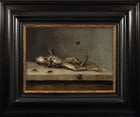 Click for larger image
Click for larger image Credit: Rob and Nick Carter, Transforming Vanitas Painting, 2013 after Ambrosius Bosschaert the Younger, Dead Frog with Flies, c.1630, In collaboration with MPC.
Three hour looped film, frame & 21.5in Apple iMac, edition of 12 + 5 artists’ proofs. © Rob and Nick Carter, Courtesy of The Fine Art Society and MPC.
Copyright the artist, reproduced with permission.
The painted frog breathes its last and slowly decomposes before our eyes. The flies buzz around, maggots appear and eventually we are left with the skeleton.
Rob and Nick Carter’s art is a memento mori with a twist, because what appears initially as a painted panel in a wooden frame (of the kind favoured by Dutch 17th-C masters), upon sustained looking reveals a screen playing a looped animated image - an updated symbolic reminder of the inevitability of death for our digital age.
The vanitas was a popular theme throughout the 1500-1600s in Western art as an exploration of death and decay often featuring depictions of skulls, flowers dropping petals, snuffed-out candles and hour-glasses, to indicate the sands of time draining away.
The theme has continued to have currency - Sam Taylor-Wood’s Still Life, of 2001, is a filmed version of fruit rotting in real time. The Carters specialise in re-working historic art and our image this month is based on the 1630 oil on copper painting, Dead Frog with Flies by Dutch artist Ambrosius Bosschaert the Younger.
In this updated version the use of digital animation makes (speeded-up) time drain away in front of us. The artists were partly motivated upon learning that the average time we spend looking at an artwork in a museum or gallery is six seconds. This is an attempt to create something that rewards sustained engagement.
This artistic duo - husband and wife team Rob and Nick Carter, were keen to ensure the viewer remain aware that this is a painted image. Yet, contrary to what we are seeing, painted images don’t move. It is this juxtaposition between the painted, by nature inanimate form, and the reality of movement that gives this work its power.
The fantastic verisimilitude takes us out of ourselves, as we temporarily suspend disbelief. We admire the technical skill. Every element has been individually modelled, texturised and animated involving several thousands of hours.
The Carter’s collaborated with the Moving Picture Company (MPC), one of the global leaders in VFX who have worked on many famous Hollywood movies. Created using Maya and rendered using Mental Ray, MPC challenged themselves to keep the brush work and paint texture from the original painting and to create a living breathing painting, brushstrokes and all.
This month a new exhibition opening in London showcases the fruits of this collaboration - Rob and Nick Carter ‘Transforming’, at The Fine Art Society (to 2 November 2013).
The exhibition shows three moving image works in this vein. The Carter’s first one, in 2012, was Transforming Still Life Painting, based on a flower piece by Ambrosius Bosschaert the Elder. This is a stunningly beautiful and amazingly life-like rendition of the original still-life painting, with insects and snails moving across and around the picture. The light transforms as the day moves from dawn to dusk and the flowers turn to face the sun.
Again the display in an antique-style frame adds to the viewer’s sense of a real oil-painting. There was obvious appeal to the visitors at the Maastricht art fair where it was first exhibited. This traditional marketplace is re-known for its old masters and this work was very well received with a number of high profile sales.
The Fine Art Society says, ‘By painstakingly re-rendering every component of the painting the whole process draws attention to the mastery of the original and allows us to consider it in a new light. The video work goes one step beyond Bosschaert, literally allowing us to see the secret life of a still life.’ Transforming Still Life Painting is currently on view at the Manchester Art Museum (to 23 May 2014) and will also be shown in New York at the Frick Collection (22 October - 19 January 2014).
Not surprisingly the artists are interested in the notion of perception and with their Pixelated Paintings, also on view in London, remind us that all artwork is in essence a careful balancing act of colour, light, space, line and form.
These Cibachrome renditions of famous paintings ask the question, ‘Are there some paintings that are so deeply embedded in our cultural psyche that we know them by sight even if they were reduced to a highly pixelated image?’ The most successful of this series is a pixelated version of the famous Henry Raeburn painting The Reverend Robert Walker Skating on Duddingston Loch (1790).
As the Fine Art Society points out, ‘Increasingly in the digital age one’s first encounter with a painting will be on the internet. The Carters have frequently considered the duality between the digital and analogue age in their practice. Here, they create a dialogue about high and low image quality.’
Also on view in the London exhibition is a sculpture, Sunflowers (2013) a digitally modeled and 3D printed completely accurate replica in bronze of Vincent Van Gogh’s masterpiece. This show is well worth making the detour to Bond Street.
Catherine Mason is the author of A Computer in the Art Room: the origins of British computer arts 1950-80, published in 2008.
More information on the Computer Arts Society, including our events programme

















